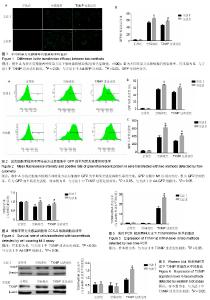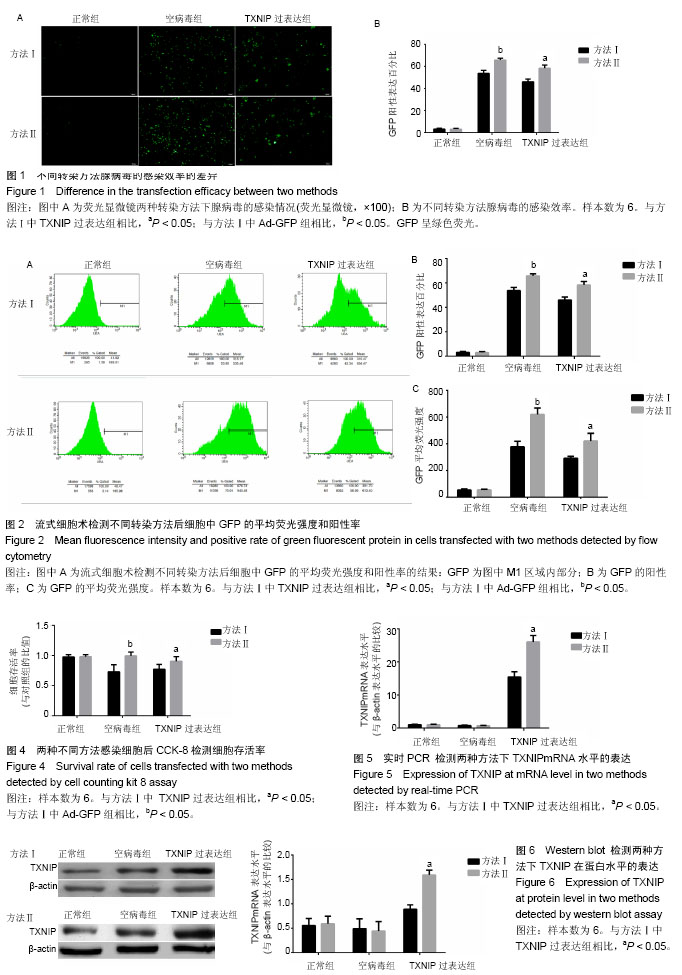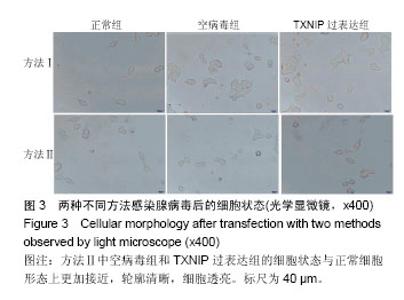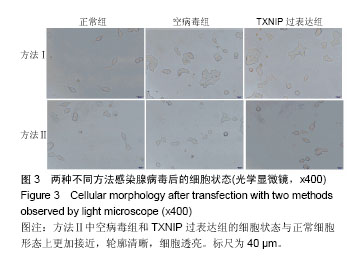Chinese Journal of Tissue Engineering Research ›› 2018, Vol. 22 ›› Issue (28): 4487-4492.doi: 10.3969/j.issn.2095-4344.0839
Previous Articles Next Articles
Differences in the construction of thioredoxin-interacting protein overexpression model in INS-1 cells by two adenovirus infection methods
Cao Zhu-jie, Feng Yan-jin, Li Dan, Wang Jin, Jiao Xiang-ying
- Department of Physiology, Key Laboratory for Cellular Physiology of Ministry of Education, Shanxi Medical University, Taiyuan 030001, Shanxi Province, China
-
Received:2017-12-26Online:2018-10-08Published:2018-10-08 -
Contact:Jiao Xiang-ying, Professor, Doctoral supervisor, Department of Physiology, Key Laboratory for Cellular Physiology of Ministry of Education, Shanxi Medical University, Taiyuan 030001, Shanxi Province, China -
About author:Cao Zhu-jie, Master candidate, Department of Physiology, Key Laboratory for Cellular Physiology of Ministry of Education, Shanxi Medical University, Taiyuan 030001, Shanxi Province, China -
Supported by:the National Natural Science Foundation of China, No. 30800399; the Shanxi Provincial Key Laboratory Construction Project, No. 2014011049-12
CLC Number:
Cite this article
Cao Zhu-jie, Feng Yan-jin, Li Dan, Wang Jin, Jiao Xiang-ying. Differences in the construction of thioredoxin-interacting protein overexpression model in INS-1 cells by two adenovirus infection methods[J]. Chinese Journal of Tissue Engineering Research, 2018, 22(28): 4487-4492.
share this article

2.1 两种转染方法下腺病毒的感染效率 荧光显微镜可见方法Ⅰ在48 h时空病毒组和TXNIP过表达组的GFP表达情况均低于Ⅱ组(P < 0.05)。Ⅰ组与Ⅱ组的正常组间GFP的表达差异无显著性意义(P > 0.05;图1)。 经流式细胞术检测可知,方法Ⅰ中空病毒组和TXNIP过表达组的GFP阳性率和平均荧光强度均高于方法Ⅱ中空病毒组和TXNIP过表达组,方法Ⅱ中空病毒组的腺病毒感染效率提高12.06%,方法Ⅱ中TXNIP过表达组的腺病毒感染效率提高12.35%(n=6,P < 0.05)。方法Ⅰ与方法Ⅱ中正常组的不同转染方法腺病毒的感染效率差异无显著性意义(n=6,P > 0.05)(图2)。以上结果表明使用方法Ⅱ腺病毒感染效率有明显提高。"

| [1] Klöppel G, Löhr M, Habich K, et al. Islet pathology and the pathogenesis of type 1 and type 2 diabetes mellitus revisited. Surv Synth Pathol Res. 1985;4(2):110-125.[2] Malone CF, Emerson C, Ingraham R, et al. mTOR and HDAC Inhibitors Converge on the TXNIP/Thioredoxin Pathway to Cause Catastrophic Oxidative Stress and Regression of RAS-Driven Tumors. Cancer Discov. 2017;7(12):1450-1463. [3] Lan XF, Zhang XJ, Lin YN, et al. Estradiol Regulates Txnip and Prevents Intermittent Hypoxia-Induced Vascular Injury. Sci Rep. 2017;7(1):10318. [4] Hou Y, Wang Y, He Q, et al. Nrf2 inhibits NLRP3 inflammasome activation through regulating Trx1/TXNIP complex in cerebral ischemia reperfusion injury. Behav Brain Res. 2018;336:32-39. [5] Liu Y, Lou G, Norton JT, et al. 6-Methoxyethylamino-numonafide inhibits hepatocellular carcinoma xenograft growth as a single agent and in combination with sorafenib. FASEB J. 2017;31(12):5453-5465. [6] Yao YL, Yang X, Xue XW, et al. Effect of adenovirus-mediated TXNIP overexpression on apoptosis and injury of H9C2 cardiomyocytes. Sheng Li Xue Bao. 2013;65(3):309-318.[7] Patwari P, Higgins LJ, Chutkow WA, et al. The interaction of thioredoxin with Txnip. Evidence for formation of a mixed disulfide by disulfide exchange. J Biol Chem. 2006;281(31):21884-21891. [8] Schulze PC, Yoshioka J, Takahashi T, et al. Hyperglycemia promotes oxidative stress through inhibition of thioredoxin function by thioredoxin-interacting protein. J Biol Chem. 2004;279(29):30369-30374. [9] Yoshioka J, Schulze PC, Cupesi M, et al. Thioredoxin-interacting protein controls cardiac hypertrophy through regulation of thioredoxin activity. Circulation. 2004;109(21):2581-2586. [10] Shalev A, Pise-Masison CA, Radonovich M, et al. Oligonucleotide microarray analysis of intact human pancreatic islets: identification of glucose-responsive genes and a highly regulated TGFbeta signaling pathway. Endocrinology. 2002;143(9):3695-3698.[11] Koenen TB, Stienstra R, van Tits LJ, et al. Hyperglycemia activates caspase-1 and TXNIP-mediated IL-1beta transcription in human adipose tissue. Diabetes. 2011;60(2):517-524.[12] Parikh H, Carlsson E, Chutkow WA, et al. TXNIP regulates peripheral glucose metabolism in humans. PLoS Med. 2007;4(5):e158.[13] Patwari P, Chutkow WA, Cummings K, et al. Thioredoxin-independent regulation of metabolism by the alpha-arrestin proteins. J Biol Chem. 2009;284(37):24996-25003.[14] Chutkow WA, Lee RT. Thioredoxin regulates adipogenesis through thioredoxin-interacting protein (Txnip) protein stability. J Biol Chem. 2011;286(33):29139-29145.[15] Chen J, Couto FM, Minn AH, et al. Exenatide inhibits beta-cell apoptosis by decreasing thioredoxin-interacting protein. Biochem Biophys Res Commun. 2006;346(3):1067-1074.[16] Sun Z, Wang C, Shi C, et al. Activated Wnt signaling induces myofibroblast differentiation of mesenchymal stem cells, contributing to pulmonary fibrosis. Int J Mol Med. 2014;33(5):1097-1109.[17] Liu FF, Liu CY, Li XP, et al. Neuroprotective effects of SMADs in a rat model of cerebral ischemia/reperfusion. Neural Regen Res. 2015;10(3):438-444.[18] Meng M. Digitoflavone (DG) attenuates LPS-induced acute lung injury through reducing oxidative stress and inflammatory response dependent on the suppression of TXNIP/NLRP3 and NF-κB. Biomed Pharmacother. 2017;94:712-725.[19] Cardoso TF, Quintanilla R, Tibau J, et al. Nutrient supply affects the mRNA expression profile of the porcine skeletal muscle. BMC Genomics. 2017;18(1):603.[20] Görgens SW, Benninghoff T, Eckardt K, et al. Hypoxia in Combination With Muscle Contraction Improves Insulin Action and Glucose Metabolism in Human Skeletal Muscle via the HIF-1α Pathway. Diabetes. 2017;66(11):2800-2807. [21] Deng Y, Han X, Yao Z, et al. PPARα Agonist Stimulated Angiogenesis by Improving Endothelial Precursor Cell Function Via a NLRP3 Inflammasome Pathway. Cell Physiol Biochem. 2017;42(6):2255-2266.[22] Mahmoudian E, Khalilnezhad A, Gharagozli K, et al. Thioredoxin-1, redox factor-1 and thioredoxin-interacting protein, mRNAs are differentially expressed in Multiple Sclerosis patients exposed and non-exposed to interferon and immunosuppressive treatments. Gene. 2017;634:29-36.[23] Harb OA, Elsayed WS, Ismail EI, et al. Thioredoxin-Interact ing-Pro t e in [TXNIP] and Transglutaminase 2 [TGM2] Expression in Meningiomas of Different Grades and the Role of Their Expression in Meningioma Recurrence and Prognosis. Asian Pac J Cancer Prev. 2017;18(8):2299-2308.[24] Walther W, Stein U. Viral vectors for gene transfer: a review of their use in the treatment of human diseases. Drugs. 2000;60(2):249-271.[25] Treacy O, Ryan AE, Heinzl T, et al. Adenoviral transduction of mesenchymal stem cells: in vitro responses and in vivo immune responses after cell transplantation. PLoS One. 2012;7(8):e42662.[26] Nayak S, Herzog RW. Progress and prospects: immune responses to viral vectors. Gene Ther. 2010;17(3):295-304.[27] Mah C, Byrne BJ, Flotte TR. Virus-based gene delivery systems. Clin Pharmacokinet. 2002;41(12):901-911.[28] Nayerossadat N, Maedeh T, Ali PA. Viral and nonviral delivery systems for gene delivery. Adv Biomed Res. 2012;1:27. [29] Shimizu K, Okamoto M, Terada T, et al. Adenovirus vector-mediated macrophage erythroblast attacher (MAEA) overexpression in primary mouse hepatocytes attenuates hepatic gluconeogenesis. Biochem Biophys Rep. 2017;10:192-197.[30] Lee CS, Bishop ES, Zhang R, et al. Adenovirus-Mediated Gene Delivery: Potential Applications for Gene and Cell-Based Therapies in the New Era of Personalized Medicine. Genes Dis. 2017;4(2):43-63.[31] Wu Y, Yang D, Xu B, et al. Immune efficacy of an adenoviral vector-based swine influenza vaccine against antigenically distinct H1N1 strains in mice. Antiviral Res. 2017;147:29-36.[32] Schaar K, Geisler A, Kraus M, et al. Anti-adenoviral Artificial MicroRNAs Expressed from AAV9 Vectors Inhibit Human Adenovirus Infection in Immunosuppressed Syrian Hamsters. Mol Ther Nucleic Acids. 2017;8:300-316.[33] Abbink P, Maxfield LF, Ng'ang'a D, et al. Construction and evaluation of novel rhesus monkey adenovirus vaccine vectors. J Virol. 2015; 89(3):1512-1522.[34] Lu Y, Wang Z, Han W, et al. Zoledronate induces autophagic cell death in human umbilical vein endothelial cells via Beclin-1 dependent pathway activation. Mol Med Rep. 2016;14(5):4747-4754.[35] Merten OW, Al-Rubeai M. Viral Vectors for Gene Therapy. New Jersey: Humana Press Inc. 2011:1-25.[36] Schaar K, Geisler A, Kraus M, et al. Anti-adenoviral Artificial MicroRNAs Expressed from AAV9 Vectors Inhibit Human Adenovirus Infection in Immunosuppressed Syrian Hamsters. Mol Ther Nucleic Acids. 2017;8:300-316. |
| [1] | Zhang Tongtong, Wang Zhonghua, Wen Jie, Song Yuxin, Liu Lin. Application of three-dimensional printing model in surgical resection and reconstruction of cervical tumor [J]. Chinese Journal of Tissue Engineering Research, 2021, 25(9): 1335-1339. |
| [2] | Zeng Yanhua, Hao Yanlei. In vitro culture and purification of Schwann cells: a systematic review [J]. Chinese Journal of Tissue Engineering Research, 2021, 25(7): 1135-1141. |
| [3] | Xu Dongzi, Zhang Ting, Ouyang Zhaolian. The global competitive situation of cardiac tissue engineering based on patent analysis [J]. Chinese Journal of Tissue Engineering Research, 2021, 25(5): 807-812. |
| [4] | Wu Zijian, Hu Zhaoduan, Xie Youqiong, Wang Feng, Li Jia, Li Bocun, Cai Guowei, Peng Rui. Three-dimensional printing technology and bone tissue engineering research: literature metrology and visual analysis of research hotspots [J]. Chinese Journal of Tissue Engineering Research, 2021, 25(4): 564-569. |
| [5] | Chang Wenliao, Zhao Jie, Sun Xiaoliang, Wang Kun, Wu Guofeng, Zhou Jian, Li Shuxiang, Sun Han. Material selection, theoretical design and biomimetic function of artificial periosteum [J]. Chinese Journal of Tissue Engineering Research, 2021, 25(4): 600-606. |
| [6] | Liu Fei, Cui Yutao, Liu He. Advantages and problems of local antibiotic delivery system in the treatment of osteomyelitis [J]. Chinese Journal of Tissue Engineering Research, 2021, 25(4): 614-620. |
| [7] | Li Xiaozhuang, Duan Hao, Wang Weizhou, Tang Zhihong, Wang Yanghao, He Fei. Application of bone tissue engineering materials in the treatment of bone defect diseases in vivo [J]. Chinese Journal of Tissue Engineering Research, 2021, 25(4): 626-631. |
| [8] | Zhang Zhenkun, Li Zhe, Li Ya, Wang Yingying, Wang Yaping, Zhou Xinkui, Ma Shanshan, Guan Fangxia. Application of alginate based hydrogels/dressings in wound healing: sustained, dynamic and sequential release [J]. Chinese Journal of Tissue Engineering Research, 2021, 25(4): 638-643. |
| [9] | Chen Jiana, Qiu Yanling, Nie Minhai, Liu Xuqian. Tissue engineering scaffolds in repairing oral and maxillofacial soft tissue defects [J]. Chinese Journal of Tissue Engineering Research, 2021, 25(4): 644-650. |
| [10] | Xing Hao, Zhang Yonghong, Wang Dong. Advantages and disadvantages of repairing large-segment bone defect [J]. Chinese Journal of Tissue Engineering Research, 2021, 25(3): 426-430. |
| [11] | Chen Siqi, Xian Debin, Xu Rongsheng, Qin Zhongjie, Zhang Lei, Xia Delin. Effects of bone marrow mesenchymal stem cells and human umbilical vein endothelial cells combined with hydroxyapatite-tricalcium phosphate scaffolds on early angiogenesis in skull defect repair in rats [J]. Chinese Journal of Tissue Engineering Research, 2021, 25(22): 3458-3465. |
| [12] | Wang Hao, Chen Mingxue, Li Junkang, Luo Xujiang, Peng Liqing, Li Huo, Huang Bo, Tian Guangzhao, Liu Shuyun, Sui Xiang, Huang Jingxiang, Guo Quanyi, Lu Xiaobo. Decellularized porcine skin matrix for tissue-engineered meniscus scaffold [J]. Chinese Journal of Tissue Engineering Research, 2021, 25(22): 3473-3478. |
| [13] | Mo Jianling, He Shaoru, Feng Bowen, Jian Minqiao, Zhang Xiaohui, Liu Caisheng, Liang Yijing, Liu Yumei, Chen Liang, Zhou Haiyu, Liu Yanhui. Forming prevascularized cell sheets and the expression of angiogenesis-related factors [J]. Chinese Journal of Tissue Engineering Research, 2021, 25(22): 3479-3486. |
| [14] | Liu Chang, Li Datong, Liu Yuan, Kong Lingbo, Guo Rui, Yang Lixue, Hao Dingjun, He Baorong. Poor efficacy after vertebral augmentation surgery of acute symptomatic thoracolumbar osteoporotic compression fracture: relationship with bone cement, bone mineral density, and adjacent fractures [J]. Chinese Journal of Tissue Engineering Research, 2021, 25(22): 3510-3516. |
| [15] | Liu Liyong, Zhou Lei. Research and development status and development trend of hydrogel in tissue engineering based on patent information [J]. Chinese Journal of Tissue Engineering Research, 2021, 25(22): 3527-3533. |
| Viewed | ||||||
|
Full text |
|
|||||
|
Abstract |
|
|||||

